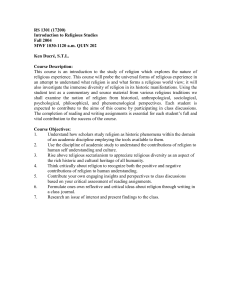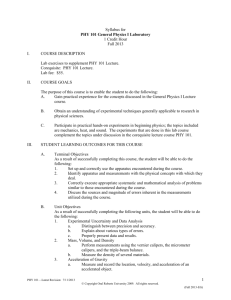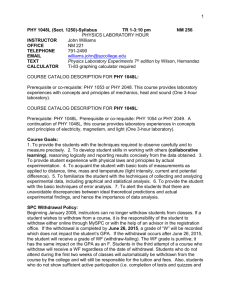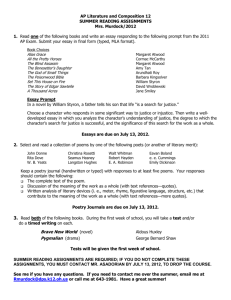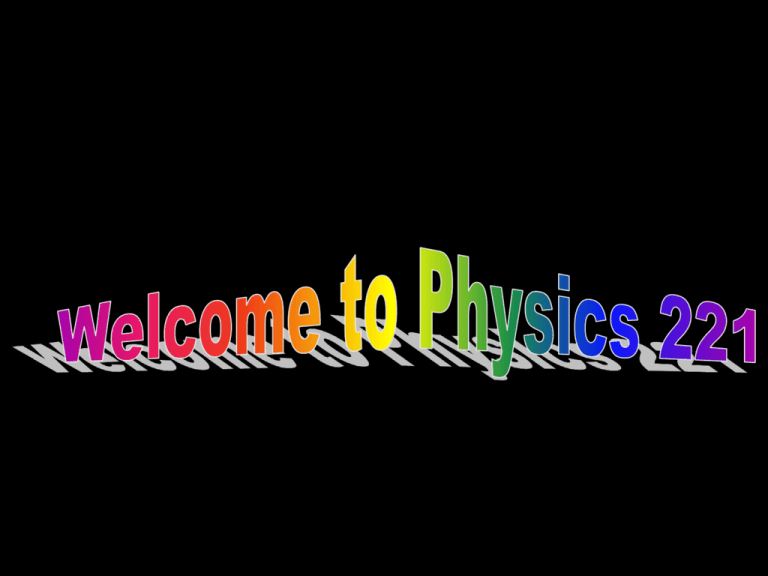
Phy 221 2006S Lecture 1
Lecture 1: Goals
• Explain key points of Syllabus.
• Introduce Units used to express physical
quantities.
• Introduce key vector concepts.
Phy 221 2006S Lecture 1
Syllabus: Basic Info
•
Where do you have to go
– The Lectures: MWF 8-8:50 9-9:50 10-10:50
– The Recitations
• Day: Tuesday at various times and alternate Thursdays: see syllabus
• Evening: Your instructor will explain the schedule at first meeting
– The Labs: Every other week
•
•
no lab first week
The Lecturers
– David Atwood 9-9:50 10-10:50 atwood@iastate.edu
• Office hours Monday and Wednesday 3-4pm or by appointment
• First week Atwood office hours will be posted on course web page.
– Paula Herrera-Siklody 8-8:50
•
•
•
siklody@iastate.edu
• Office hours Wednesday 9-10am or by appointment
The Textbook: University Physics (11th Edition), Young and Freedman
(Pearson, Addison Wesley 2003)
Lab Manual: Required for Lab portion of course. Purchase at
Bookstore.
Web Page: http://www.public.iastate.edu/~atwood/phy221.html
Evening Exams
•
•
•
•
•
•
This Course has 2 hour Evening midterm Exams
– Thursday February 16 8:00pm-10:00pm
– Thursday March 30 8:00pm-10:00pm
You need to appear at these times at room assignments TBA
If you have some problem with these times you need to discuss the
issue with Dr. Atwood.
One makeup midterm at time TBA during dead week.
You may write the makeup if miss a midterm. Provided you have obtain
approval from Dr. Atwood.
Inform Dr. Atwood ASAP when you miss a midterm.
– If you missed a midterm because of illness, inform Dr. Atwood the
day of the midterm or the day after
– If you know in advance you need to miss a midterm, inform Dr.
Atwood in advance
• Exam Aids: On the midterm and final exams you can use the
following aids:
– A calculator
– An “Aid Sheet”- a single 8½11 page of notes (can write on both
sides)
WebCT
•
This course extensively uses WebCT for:
– Some assignments:
• Homework due Thursday
• Preflights due MWF both at 8am.
•
•
•
•
•
– View your grades
– Communication: Solutions; discussions; slides
All students are required to use WebCT
Your ISU NetID and Password allows access to WebCT
You should be able to log in within 2 days of registration in the course.
Please check login this week (see web page for details) and do nongraded sample quiz titled “do this quiz first”.
If you are not registered on WebCT, eg due to enrolment trouble or
any other reason, send Dr. Atwood an email with your ISU NetID,
Section# and Lab# (if known). He will put you in by hand.
(atwood@iastate.edu)
Phy 221 2006S Lecture 1
Goals of Course
Conceptual Understanding: More than just learning a few equations
•ACTs
•Recitation activities
•Problems
Introduction to Classical Physics
Key Scientific and Engineering Skills
•Problem Solving
•Scientific Communication
•The laws of Motion
•Working with Laws of motion
•Conservation Laws
•Some Forces of Nature
•Gravitation
•Electric Force
•Application to Electrical circuits
Assignments
•
•
Reading Assignments: Do them
Course:
•
Lab
– To help you with the reading assignments, there is a short “preflight” due
at 8am on lecture days starting with Lecture 3 (Jan 13). Preflights for
lecture 3-5 are ungraded. For preflights you have only one try.
– Each Thursday starting Jan 12 there is a longer WebCT homework
assignment. The Jan 12 assignment is ungraded.
– Each Tuesday starting Jan 17 there is a written assignment due to your
recitation instructor at the beginning of recitation. Assignments are
posted on WebCT two weeks before due date.
– On Tuesday recitations starting Jan 17 there is a 20 min quiz.
– On Thursday recitations there is a “Group Problem Solving” exercise.
– The prelab in your lab manual is due to your lab instructor before the lab.
– Your lab instructor will send you away if you don’t have your prelab.
– Exception: for first lab fill out “prelab 0” and hand it in to your instructor
• The first lab has a post-lab exercise instead of a prelab exercise.
• Therefore for the second lab you need to bring the prelab for that lab
and the post-lab for the first lab.
– Lab Report
• To be handed in at the end of the lab period
Lab Waiver
• If you are repeating this course but have previously
successfully completed the lab portion I suggest you
• This will exempt you from having to do the labs this
time around.
• Forms are available from Deb Schmidt in Physics
Room 12.
• Please double check a few weeks later to ensure that
your lab waiver is approved.
Some of your fellow students are
waiting for your lab spot.
Phy 221 2006S Lecture 1
Grading
• The grading scheme is*:
Item
Final Exam
2 Midterms
WebCT Homework
Preflights
Recitation Quizes
Written Homework
Group Problems
Labs
Total
Normal Lab Waiver
270
270
370
370
70
85
40
55
70
90
70
90
30
40
70
0
1000
1000
Basic Letter Grade Thresholds:
[C
F][D
400
500
600
[B
700
Phy 221 2006S Lecture 1
Grading Scale
>800
>A>700
>B>600
>C>500
>D<500
F
[A
800
900
1000
Grade Breakdown
WebCT HW
Written HW
Quizzes
2 Midterms
Lab
Preflights
Group Problems
Final
Notes:
•Grading is absolute (except for a small per TA adjustment of Written assignments quizzes and
labs)
•We will not raise the grade thresholds but may lower them if necessary.
•About 16% of final exam consists of lab questions. All students, even those with lab waivers, are
responsible for doing these questions.
•Please frequently check your grades for accuracy. In particular during Week 9 double check
grades for assignments due before Feb. 24. After Week 9 those grades will be locked in. Likewise
during week 15 double check grades for assignments due before April 14
Regardless of your grade, you will
fail if…
• Any laboratory has not been satisfactorily
completed (see lab sheet handed out first
recitation)
• The student has engaged in any form of
academic dishonesty.
Phy 221 2006S Lecture 1
Assistance
• The Help Room located in room B54.
– Starts operation Jan. 18 at 9am.
– Schedule posted on door and on WebCT
– To get more attention, go there during offpeak hours
• Useful Material and announcements will be posted on
WebCT.
– There is also a Discussion Board.
• Supplemental Instruction will be available and
announced when organized.
• The Dean of Students Office: Academic Success
Center
http://www.dso.iastate.edu/dept/asc/tutoring.htm
matches students or groups of students with
advanced students for tutoring at a modest fee.
Phy 221 2006S Lecture 1
Miscellaneous
• Students with SAAR forms need to file them with
Dr. Atwood during the first two weeks of class or as
soon as possible after the form is issued.
• The “University Physics, Student Solutions Manual”
contains solutions to some of the back of chapter
problems. Working through problems is an excellent
method to study. On WebCT I list a number of
additional sources of problems that you might find
useful.
Phy 221 2006S Lecture 1
Units
• In physics we need to describe the real
world so a system of units is required.
• Scientists and engineers around the world
use the SI system.
• The metric system based on SI is used for
conventional measures in all countries aside
from the USA.
This is the system we will use in this course.
Phy 221 2006S Lecture 1
Basis Units
• Three basic units of SI with English system
equivalents are the following (four others are also
defined):
– Length: The meter (1 m = 3.281 ft)
– Mass: The kilogram (1kg=.06585 sg)
• on Earth 1kg weighs 2.205 lb
• on the Moon 1kg weighs 0.368 lb
– Time: The second (same as English system)
– Some other kinds of units can be expanded as products or
ratios of these units: For example:
• Unit of speed m/s
• The ‘derived’ unit for force (Newton) is 1N=1 kg m/s²
• Additional abbreviations are sometimes introduced as a short
form for combinations of basic units, for example the Newton
(N) above.
Phy 221 2006S Lecture 1
Multiples of Units
Power
of 10
Prefix
10-24
yocto-
y
10-21
zepto-
z
10-18
atto-
a
10-15
femto-
f
10-12
pico-
p
10-9
nano-
n
10-6
micro-
The Greek Letter “mu”
10-3
milli-
m
Do not confuse with
10-2
centi-
c
103
kilo-
k
106
mega-
M
109
giga-
G
1012
tera-
T
1015
peta-
P
1018
exa-
E
1021
zetta-
Z
1024
yotta-
Y
Formal conversion of units:
Symbol
•Multiply by the appropriate
representation of 1 to cancel the
unwanted units away:
•eg. convert 10 mi/hr into m/s
eg. 1 kilometer=
1 km=1000m
mi
mi 1hr 1609m
10
10
hr
hr 3600s 1mi
10 1 1609 mi hr m
3600 hr s mi
=4.47 m/s
Phy 221 2006S Lecture 1
Consistency of Equations
• If A=B then A and B must have the same
combination of units (dimensionality).
• For example
(distance)=(speed)(time)
[m] = ([m]/[s]) [s]
• The famous equation
E=mc²
[m]
[kg][ m]
([ kg])
2
[ s]
[ s]
2
2
Phy 221 2006S Lecture 1
Vectors
• A scalar quantity is one that is represented
by a single number
– mass; length; time; temperature; volume etc.
• A vector is a quantity which has both
magnitude and direction.
• In physics we need vectors because the real
world is (at least) 3 dimensional.
Phy 221 2006S Lecture 1
Location in Space
• To locate an object in space we need to establish a
coordinate system with an origin and axes.
• Points are located by giving their x and y (and z)
coordinates.
y
A vector describes a displacement or
from one point to another
7
A
(1,5)
6
5
4
3
2
1
C
VAB=(4,-2)
B
(5,3)
(3,2)
The components of the vector describe
the displacement in the x and y direction.
Two vectors are parallel if they describe
the same displacement even if that
displacement begins at different points.
x
origin
1
2 3
4
5
6 Phy7221 2006S Lecture 1
Vector Addition
A+B=C
Geometrically: Parallel transport the tail of B to the head
of A. The sum goes from the tail of A to the head of B.
Note: This construction only works if head of A is at the tail of
B. Otherwise you need to move B to make that true
Algebraically: Add the components
C(3,5)
B(-2,4)
A (5,1)
A 5
B -2
C 3
1
4
5
Vector addition is commutative and associative
Phy 221 2006S Lecture 1


